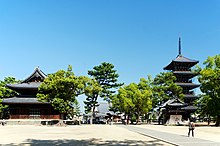Zentsū-ji
| Byōbuura Gogakusan Tanjō-in Zentsū-ji | |
|---|---|
 | |
| Religion | |
| Affiliation | Shingon Buddhism |
| Location | |
| Location | 3-1, Zentsūji-cho, Zentsūji, Kagawa |
| Country | Japan |
| Architecture | |
| Founder | Kūkai |
| Date established | 807 |

The Byōbuura Gogakusan Tanjō-in Zentsū-ji (屏風浦五岳山誕生院善通寺) is a Buddhist temple of the Shingon sect in Zentsūji, Kagawa, Japan. It was established in 807 by Kūkai, founder of Shingon Buddhism, who was born where the temple now stands.[1] The oldest structure, the Shakadō Hall, dates to around 1677.
Zentsū-ji is the 75th temple of the Shikoku Pilgrimage. It is also one of the three temples on the tour that Kūkai visited, the others being Tairyūji and Muroto Misaki, as Kūkai mentioned them by name in his writings.[citation needed]
The temple is divided into the east precinct (tō-in) centered around the main hall (the Kondō Hall) and the west precinct (sai-in), where the Mieidō Hall stands over Kūkai's birthplace. The temple grounds burned down in the 16th century during the war-torn Sengoku period, and many structures have been destroyed and rebuilt over the centuries.[1][2]
Notable buildings
East precinct (tō-in)
- Gojūnotō – five-storied pagoda and tallest temple structure. Current pagoda completed in 1902.[3] An Important Cultural Property of Japan.
- Kondō Hall– the main hall (hondō) of the temple. Last rebuilt in 1699.[2] An Important Cultural Property.
- Shakadō Hall – formerly stood over Kukai's birthplace as the Mieidō Hall until moved and renamed in 1831. Built sometime 1673–1680.[2] A Registered Tangible Cultural Property.
- Bell tower – Registered Tangible Cultural Property.
- Nandaimon – Registered Tangible Cultural Property
- Chūmon
West precinct (sai-in)
- Mieidō Hall – stands over Kūkai's birthplace. Current structure built in 1831; renovated in 1937. A Registered Tangible Cultural Property.[2]
- Nio gate – It was rebuilt in 1889. Registered Tangible Cultural Property.
- Gomadō – It was rebuilt in 1889. Registered Tangible Cultural Property.
- Henjōkaku
Temple treasures
- Gilt bronze finial of a pilgrim's staff – National Treasure
- Preface to the Lotus Sutra decorated with Buddhas – National Treasure
- Jizō Bosatsu ryūzō – Important Cultural Property
- Kichijōten ryūzō – Important Cultural Property
Gallery
-
 Kondō Hall (main hall)
Kondō Hall (main hall) -
 Nio Gate and Kairō
Nio Gate and Kairō -
 Mieidō Hall
Mieidō Hall -
 Henjōkaku
Henjōkaku -

See also
- Qinglong Temple - temple in China that Kūkai modeled Zentsuji after
- National Treasures of Japan
- List of National Treasures of Japan (writings)
- List of National Treasures of Japan (crafts: others)
References
- ^ a b "Kondo Hall". Cultural Properties Database (in Japanese). Agency for Cultural Affairs. Retrieved 15 September 2021.
See "detailed information" (詳細解説) tab at bottom (in Japanese)
- ^ a b c d "History of Zentsuji Temple (after 1700)" (in Japanese).
- ^ "Five-storied pagoda". Zentsuji Temple (in Japanese). Retrieved 15 September 2021.
External links

- About ZENTSUJI
- (in English) Zentsuji temple - Kagawa Prefecture - Japan travel guide-title
- (in English) Fox and Amy in Japan Zentsuji Temple
- (in English) Zentsuji Temple Kotohira 2 Shikoku Japan Travel Guide and Information att.JAPAN
- (in English) Documentary movie about the 88 Temple Pilgrimage
- Guide to start the Shikoku 88 temples pilgrimage (french-english)
- (in English) Echoes of Incense - A Pilgrimage in Japan by Don Weiss
- (in English) A Shikoku Pilgrimage by Jasbir Sandhu
- v
- t
- e
| Architectonic elements | |
|---|---|
| Mon (gates) | |
| Buildings |
|
| Japanese pagodas | |
| Styles | |
| Others |
|
| Major schools | |
|---|---|
| Zen schools | |
| Nanto rokushū | |
| Objects of worship |
| Implements |
|
|---|---|
| Others |
34°13′30.4″N 133°46′26.9″E / 34.225111°N 133.774139°E / 34.225111; 133.774139
 | This article about a Japanese religious building or structure is a stub. You can help Wikipedia by expanding it. |
- v
- t
- e
 | This article about a Buddhist place of worship is a stub. You can help Wikipedia by expanding it. |
- v
- t
- e
















